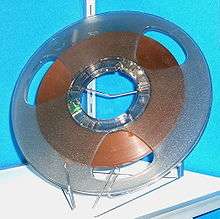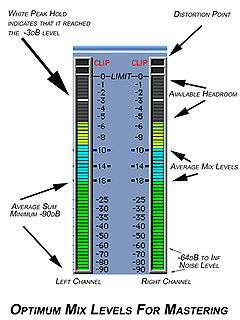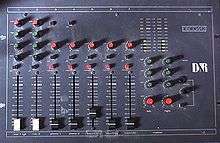Audio mastering

Mastering, a form of audio post production, is the process of preparing and transferring recorded audio from a source containing the final mix to a data storage device (the master); the source from which all copies will be produced (via methods such as pressing, duplication or replication). In recent years digital masters have become usual although analog masters, such as audio tapes, are still being used by the manufacturing industry, notably by a few engineers who have chosen to specialize in analog mastering.
Mastering requires critical listening; however, software tools exist to facilitate the process. Mastering is a crucial gateway between production and consumption and, as such, it involves technical knowledge as well as specific aesthetics.[1] Results still depend upon the accuracy of speaker monitors and the listening environment. Mastering engineers may also need to apply corrective equalization and dynamic compression in order to optimise sound translation on all playback systems.[2] It is standard practice to make a copy of a master recording, known as a safety copy, in case the master is lost, damaged or stolen.
History
Pre-1940s
In the earliest days of the recording industry, all phases of the recording and mastering process were entirely achieved by mechanical processes. Performers sang and/or played into a large acoustic horn and the master recording was created by the direct transfer of acoustic energy from the diaphragm of the recording horn to the mastering lathe, typically located in an adjoining room. The cutting head, driven by the energy transferred from the horn, inscribed a modulated groove into the surface of a rotating cylinder or disc.[3] These masters were usually made from either a soft metal alloy or from wax; this gave rise to the colloquial term waxing, referring to the cutting of a record.[4]
After the introduction of the microphone and electronic amplifier in the mid-1920s, the mastering process became electro-mechanical, and electrically driven mastering lathes came into use for cutting master discs (the cylinder format by then having been superseded). Until the introduction of tape recording, master recordings were almost always cut direct-to-disc.[3] Only a small minority of recordings were mastered using previously recorded material sourced from other discs.
Emergence of magnetic tape
In the late 1940s, the recording industry was revolutionized by the introduction of magnetic tape. Magnetic tape was invented for recording sound by Fritz Pfleumer in 1928 in Germany, based on the invention of magnetic wire recording by Valdemar Poulsen in 1898. Not until the end of World War II could the technology be found outside of Europe. The introduction of magnetic tape recording enabled master discs to be cut separately in time and space from the actual recording process.[3]
Although tape and other technical advances dramatically improved audio quality of commercial recordings in the post-war years, the basic constraints of the electro-mechanical mastering process remained, and the inherent physical limitations of the main commercial recording media—the 78 rpm disc and the later 7-inch 45 rpm single and the 33-1/3 rpm LP record—meant that the audio quality, dynamic range,[lower-alpha 1] and running time[lower-alpha 2] of master discs were still limited compared to later media such as the compact disc.
Electro-mechanical mastering process
From the 1950s until the advent of digital recording in the late 1970s, the mastering process typically went through several stages. Once the studio recording on multi-track tape was complete, a final mix was prepared and dubbed down to the master tape, usually either a single-track mono or two-track stereo tape. Prior to the cutting of the master disc, the master tape was often subjected to further electronic treatment by a specialist mastering engineer. After the advent of tape it was found that, especially for pop recordings, master recordings could be made so that the resulting record would sound better. This was done by making fine adjustments to the amplitude of sound at different frequency bands (equalization) prior to the cutting of the master disc.
Record mastering became a highly prized and skilled craft, and it was widely recognized that good mastering could make or break a commercial pop recording. As a result, the independent mastering studio was born. Early independent mastering engineers included Doug Sax, Bob Ludwig, Bob Katz and Bernie Grundman and Denny Purcell.[3]
In large recording companies such as EMI, the mastering process was usually controlled by specialist staff technicians who were conservative in their work practices. These big companies were often reluctant to make changes to their recording and production processes—for example, EMI was very slow in taking up innovations in multi-track recording[lower-alpha 3] and they did not install 8-track recorders in their Abbey Road Studios until the late 1960s, more than a decade after the first commercial 8-track recorders were installed by American independent studios.[5]
Digital technology

In the 1990s, electro-mechanical processes were largely superseded by digital technology, with digital recordings stored on hard disk drives or digital tape and transferred to CD. The digital audio workstation (DAW) became common in many mastering facilities, allowing the off-line manipulation of recorded audio via a graphical user interface (GUI). Although many digital processing tools are common during mastering, it is also very common to use analog media and processing equipment for the mastering stage.[2] Just as in other areas of audio, the benefits and drawbacks of digital technology compared to analog technology are still a matter for debate. However, in the field of audio mastering, the debate is usually over the use of digital versus analog signal processing rather than the use of digital technology for storage of audio.[2]
Although there is no "optimum mix level for mastering", the example in the adjacent picture only suggests what mix levels are ideal for the studio engineer to render and for the mastering engineer to process.[6] It is important to allow enough headroom for the mastering engineer's work.[7] Reduction of headroom by the mix or mastering engineer has resulted in a loudness war in commercial recordings.[8]
Mastering has a special significance for house, techno and other styles of electronic dance music:
...the product of mastering, regardless of the type of format, is re-actualised into a performance in the hands of the DJ. In this regard, the shift from vinyl records to digital formats in many DJ scenes and the appearance of new digital formats for DJs have encouraged new practices also among mastering engineers, whose targets are not only music listeners but, specifically, music performers as well.[9]
Process

The source material, ideally at the original resolution, is processed using equalization, compression, limiting, noise reduction and other processes. More tasks, such as editing, pre-gapping, leveling, fading in and out, noise reduction and other signal restoration and enhancement processes can be applied as part of the mastering stage.[8] This step prepares the music for either digital or analog, e.g. vinyl, replication. The source material is put in the proper order, commonly referred to as assembly (or 'track') sequencing.
If the material is destined for vinyl release, additional processing, such as dynamic range reduction or frequency dependent stereo–to–mono fold-down and equalization, may be applied to compensate for the limitations of that medium. Finally, for compact disc release, Start of Track, End of Track, and Indexes are defined for disc navigation. Subsequently, it is rendered either to a physical medium, such as a CD-R or DVD-R, or to computer files, such as a Disc Description Protocol (DDP) file set or an ISO file. The specific medium varies, depending on the intended release format of the final product. For digital audio releases, there is more than one possible master medium, chosen based on replication factory requirements or record label security concerns. Regardless of what delivery method is chosen, the replicator will transfer the audio to a glass master that will generate metal stampers for replication.
The process of audio mastering varies depending on the specific needs of the audio to be processed. Mastering engineers need to examine the types of input media, the expectations of the source producer or recipient, the limitations of the end medium and process the subject accordingly. General rules of thumb can rarely be applied.
Steps of the process typically include the following:
- Transferring the recorded audio tracks into the Digital Audio Workstation (DAW).
- Sequence the separate songs or tracks as they will appear on the final release.
- Adjust the length of the silence between songs.
- Process or "sweeten" audio to maximize the sound quality for the intended medium (e.g. applying specific EQ for vinyl).
- Transfer the audio to the final master format (CD-ROM, half-inch reel tape, PCM 1630 U-matic tape, etc.).
Examples of possible actions taken during mastering:[8]
- Editing minor flaws.
- Applying noise reduction to eliminate clicks, dropouts, hum and hiss.
- Adjusting stereo width.
- Adding ambience.
- Equalize audio across tracks for the purpose of optimized frequency distribution.
- Adjust volume.
- Dynamic range compression or expansion.
- Peak limit.
- Dither.
To finish mastering a CD, track markers must be inserted, along with International Standard Recording Code (ISRC) and other information necessary to replicate a CD. Vinyl LP and cassettes have their own pre-duplication requirements for a finished master.
See also
Notes
- ↑ Dynamic range was limited by the fact that if the signal level coming from the master tape was too high, the cutting head might be damaged during the cutting process or the stylus may jump out of the groove during playback.[3]
- ↑ Running times were constrained by the diameter of the disc and the density with which grooves could be inscribed on the surface without cutting into each other.
- ↑ In multi-track recording each signal input is recorded to its own track on a multi-track recorder. This multi-track tape is mixed down to a mono or stereo tape from which the master tape is copied. A multi-track tape may be remixed many times, in different ways, by different engineers, giving the possibility of several masters (mono version, stereo version, LP version, AM radio version, single version, etc.).
References
- ↑ Nardi, Carlo (2014). "Gateway of Sound: Reassessing the Role of Audio Engineering in the Art of Record Production", DanceCult 6(1), 8–25.
- 1 2 3 Mix Magazine: Issues in Modern Mastering Archived May 24, 2007, at the Wayback Machine.
- 1 2 3 4 5 Robert Auld. "Mastering Then and Now". Retrieved 2016-01-19.
- ↑ "New Technique Aids LP Waxing", Billboard, 1950-03-25
- ↑ Martin, George; Hornsby, Jeremy (1994). All you need is ears. Macmillan. p. 143. ISBN 0-312-11482-6.
- ↑ Bob Katz Mixing Tips Archived August 27, 2007, at the Wayback Machine.
- ↑ How much headroom for mastering? Archived September 6, 2012, at the Wayback Machine.
- 1 2 3 Shelvock, Matt (2012). Audio Mastering as Musical Practice. Ontario, Canada: ETDR: University of Western Ontario. pp. 1–72.
- ↑ Nardi, Carlo (2014). "Gateway of Sound: Reassessing the Role of Audio Engineering in the Art of Record Production", DanceCult 6(1), 9.
